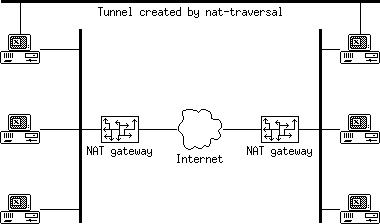Nattraversal
nat traversal Makes LowID to LowID connections posible in most cases by creating a tunnel.
[image: ]
]
1. The local client (A) is a normal NATed client, the remote client (B) is behind a Full Cone NAT (incoming UDP packets from any host will be forwarded instantly)
In this case we don’t need the KAD buddy, we send a UDP packet (2 bytes ProtID+Opcode) (NAT Ping) to B this enabling our NAT to forward incoming packets to us. The remote side answers with a own ping when we gets the remote NAT ping we have a tunnel….
2. Client A is behind a Full Cone NAT and client B is behind a normal NAT We send ping request over the buddy (E) of B, When B receives it he send’s a NAT ping packet to us, when we receive the packet we have a tunnel…
3. A and B are behind normal NATs A sends a ping request over E to B and in the request request’s a remote request. When B receives the Ping request from E he sends a NAT Ping to A, whitch is expected to be dropped on A’s NAT. And He sends a own Ping request to A over A’s buddy E2. When A gets the remote Ping Request he have the most actual extern UDP port of B and send a NAT Ping on this port. B receives the NAT ping and answers with a own second NAT Ping, when the ping arrives by A we have a Tunel…
3b. A and B are behind normal NATs, we trust the UDP port B have published on KAD A sends a ping request over E to B and at the same time sends a NAT Ping to B, this enabling our NAT to forward packets from B to us, the ping is expected to be dropped on B’s NAT. When B receives the Ping request from E he sends a NAT Ping to A, when the ping arrives by A we have a Tunel…
When A see that a tunnel is established he send’s a NAT Config Packet which contains some configuration informations for the Streaming connection. When B receives the config he send the own config. At the moment when A or B have send a config and got the remote the Streaming connection is being activated. A have the choice to send the config or not to send, in case he don’t send we remain in UDP mode for example for an UDP file Reask Ping saving us some overhead.
developed by david xanatos, Neomule.